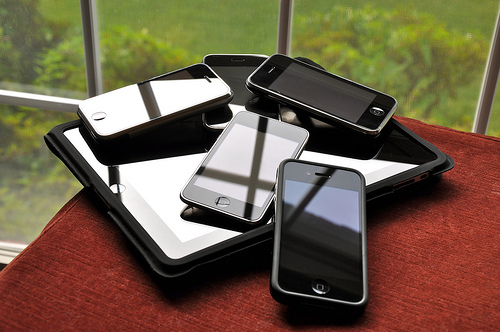
I’m no fan of hashtags, but the #muslimrage one is brilliant. Here are some links:
Bigger is better, at least when it comes to advertising. The New York Times takes a look at why mobile advertising pretty much still stinks. The simple problem: The screen size is too small. In fact, I can’t read most mobile ads on my iPhone. Maybe the bigger screen will help that. Or maybe mobile advertising needs to be rethought away from typical tiny display ads. (The New York Times)
Mobile is really under the microscope now. Facebook is the poster child for just how hard it is to figure out a workable ad model there. The backlash against mobile ads is interesting to see, considering how many of the same people were breathlessly hyping it not so long ago. Look at mobile click-through rates. They were supposed to be so much higher on mobile because advertisers have more real estate, users are more engaged, etc. Turns out they’re higher because people have fat thumbs. Now data is emerging that 40 percent of the clicks are worthless. That means we’ll end up hearing a lot more about “engagement.” (eMarketer)
Figuring out mobile and social needs to be top of mind, according to Betaworks CEO John Borthwick. The new owner of Digg believes Facebook has a leg up on figuring this out, if only because it has 950 million users. The key, in his view, will be introducing “conversational marketing” into mobile. Zuckerberg made the comparison of the mobile medium to TV, which doesn’t strike Borthwick as completely apt. “That’s one of the big questions we and others are trying to unpack,” he said. (Blooomberg TV)
Most Silicon Valley companies go through agonizing struggles between their tech roots and their media business models. Lean too much toward media, you’re a sellout. That’s where Twitter’s at right now. Give it credit for making a decisive move to build a full-on media company. Being a media company means controlling the user experience. And that’s why it’s shutting down third parties providing core services. The most recent ones to get the boot: image services like yFrog and Twitpic. The Valley will wring its hands over this, but it’s really just part of Twitter growing up — yes, as a media company. (BuzzFeed)
Startups are hot now. They’ve gone from a fringe activity in Silicon Valley to a fashionable choice. A big part of this move is the drastically reduced costs of starting a company, at least a Web service, thanks to free and low-cost products like Google apps, Amazon Web Services, among others. It stands to reason that many in the agency world are also feeling this itch. Six agency creative directors turned entrepreneurs are presenting why they made the leap in an event this Thursday at the Art Directors Club in New York. I’m going to emcee the event and hope to probe the good, the bad and the unexpected of what the participants found in startup land. (Art Directors Club)
More in Media

Digiday+ Research: Publishers’ growing focus on video doesn’t translate to social platforms
Major publishers have made recent investments in vertical video, but that shift is not carrying over to social media platforms.

Technology x humanity: A conversation with Dayforce’s Amy Capellanti-Wolf
Capellanti-Wolf shared insight on everything from navigating AI adoption and combating burnout to rethinking talent strategies.

How The Arena Group is rewriting its commercial playbook for the zero-click era
The company is testing AI-powered content recommendation models to keep readers moving through its network of sites and, in doing so, bump up revenue per session – its core performance metric.





